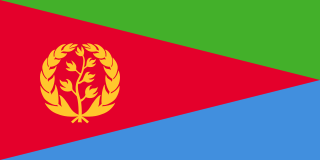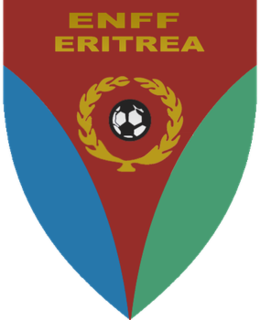Contents



"Eritrea" is an ancient name, associated in the past with its Greek form Erythraia, Ἐρυθραία, and its derived Latin form Erythræa. This name relates to that of the Red Sea, then called the Erythræan Sea, from the Greek for "red", ἐρυθρός, erythros. The Italians created the colony of Eritrea in the 19th century around Asmara, and named it with its current name. After World War II Eritrea was annexed to Ethiopia. In 1991 the communist Ethiopian government was toppled by Eritrean forces and earned their independence. Eritrea officially celebrated its 1st anniversary of independence on April 27, 1994.

Eritrea is located in the Horn of Africa and is bordered on the northeast and east by the Red Sea, on the west and northwest by Sudan, on the south by Ethiopia, and on the southeast by Djibouti. The country has a high central plateau that varies from 1,800 to 3,000 meters (5,906–9,843 ft) above sea level. A coastal plain, western lowlands, and some 350 islands comprise the remainder of Eritrea's land mass.

The Eritrean Defence Forces (EDF) are the combined military forces of Eritrea composed of three branches: Eritrean Army, Eritrean Air Force and Eritrean Navy. The Army is by far the largest, followed by the Air Force and Navy. The Commander-in-Chief of the EDF is the President of Eritrea. Their military role stems from Eritrea's strategic geographical location, located on the Red Sea with a foothold on the Bab-el-Mandeb strait.

Asmara, or Asmera, is the capital and most populous city of Eritrea, in the country's Central Region. It sits at an elevation of 2,325 metres (7,628 ft), making it the sixth highest capital in the world by altitude. The city is located at the tip of an escarpment that is both the northwestern edge of the Eritrean Highlands and the Great Rift Valley in neighbouring Ethiopia. In 2017, the city was declared as a UNESCO World Heritage Site for its well-preserved modernist architecture. The site of Asmera was first settled in 800 BC with a population ranging from 100 to 1,000. The city was then founded in the 12th century AD after four separate villages unified to live together peacefully after long periods of conflict. Under Italian rule the city of Asmara was made capital of Eritrea in the last years of the 19th century.

Massawa is a port city in the Northern Red Sea region of Eritrea, located on the Red Sea at the northern end of the Gulf of Zula beside the Dahlak Archipelago. It has represented a historically important port for many centuries.

The regions of Eritrea are the primary geographical divisions through which Eritrea is administered. Six in total, they include the Central, Anseba, Gash-Barka, Southern, Northern Red Sea and Southern Red Sea regions.

The Dahlak Archipelago is an island group located in the Red Sea near Massawa, Eritrea. It consists of two large and 124 small islands. The pearl fisheries of the archipelago have been famous since Roman times and still produce a substantial number of pearls.

The Eritrea national football team represents Eritrea in men's international football and it is controlled by the Eritrean National Football Federation (ENFF). It is nicknamed the Red Sea Boys. It has never qualified for the finals of the FIFA World Cup and the Africa Cup of Nations. Local side Red Sea FC are the main supplier for the national team, The team represents both FIFA and Confederation of African Football (CAF).

Adulis was an ancient city along the Red Sea in the Gulf of Zula, about 40 kilometers (25 mi) south of Massawa. Its ruins lie within the modern Eritrean city of Zula. It was the emporium considered part of the D’mt and Aksumite empires. It was close to Greece and the Byzantine Empire, with its luxury goods and trade routes. Its location can be included in the area known to the ancient Egyptians as the Land of the Gods, perhaps coinciding with the locality of Wddt, recorded in the geographical list of the Eighteenth Dynasty of Egypt.

The Southern Red Sea Region is an administrative region of Eritrea. It lies along the southern half of the Red Sea, and contains the coastal city of Assab. It borders the Northern Red Sea Region, and has an area of around 27,600 km2 (10,700 sq mi).

The Northern Red Sea Region is an administrative region of Eritrea. It lies along the northern three quarters of the Red Sea, and includes the Dahlak Archipelago and the coastal city of Massawa.
The Eritrean Premier League is the highest division in football in Eritrea. The league was delivered in 1994 to the first time.
Articles related to Eritrea include:
The Aligide River is a watercourse in Eritrea. It has its source a short distance outside of the national capital, Asmara. The river flows down the Eastern Escarpment of Eritrea until the small town of Foro near the Red Sea coast. At this point, the Aligide merges with two other rivers, the Comaile River and the Haddas River. It continues from there until it empties into the Red Sea.
The wildlife of Eritrea is composed of its flora and fauna. Eritrea has 96 species of mammals and a rich avifauna of 566 species of birds.

The following outline is provided as an overview of and topical guide to Eritrea:

Eritrea, officially the State of Eritrea, is a country in the Horn of Africa region of Eastern Africa, with its capital at Asmara. It is bordered by Ethiopia in the south, Sudan in the west, and Djibouti in the southeast. The northeastern and eastern parts of Eritrea have an extensive coastline along the Red Sea. The nation has a total area of approximately 117,600 km2 (45,406 sq mi), and includes the Dahlak Archipelago and several of the Hanish Islands.

Red Sea Football Club is an Eritrean football club based in Asmara. With 13 league titles they are the most successful club in the country.
Football is the most popular sport in Eritrea. After being under Ethiopian control, Eritrea gained its independence in 1991 and in 1998 the country became a member of FIFA.
The Tigrinya people, also known as Tigrigna, are an ethnic group indigenous to Eritrea. The Tigrinya people are the largest ethnic group in Eritrea, accounting for approximately 55 percent of the country's population. There also exist sizable Tigrinya communities in the diaspora. They speak the Tigrinya language.